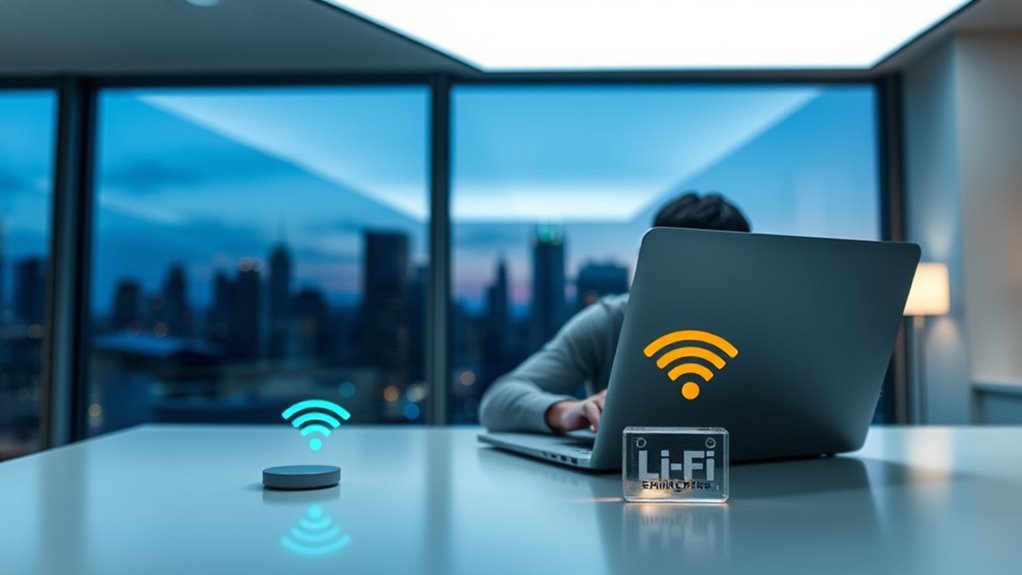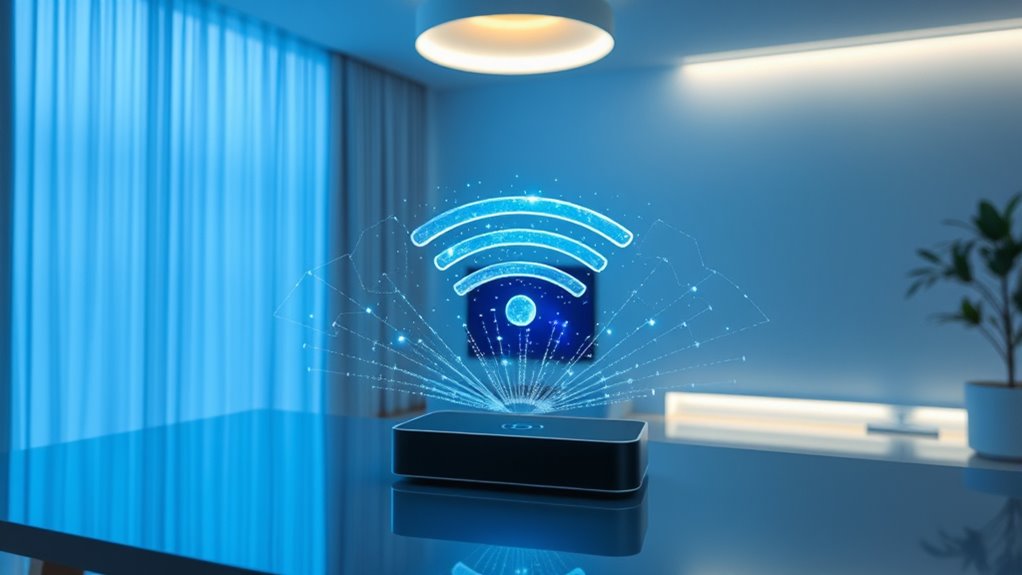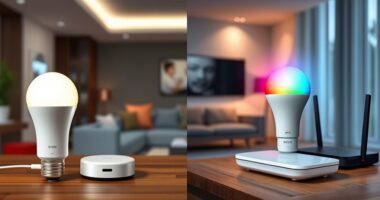Li-Fi uses visible light from LED bulbs to send data, offering higher security and energy efficiency by keeping signals within a room and reducing hacking risks. Wi-Fi remains more practical for broad coverage and device compatibility. While Li-Fi‘s security advantages make it ideal for sensitive settings, it’s still emerging and limited in range. If you want to explore how these technologies compare and what the future holds, keep exploring the details behind each option.
Key Takeaways
- Wi-Fi offers broad coverage and compatibility, making it ideal for general internet access, while Li-Fi is more secure but limited in range.
- Li-Fi provides enhanced security for sensitive data due to light confinement, whereas Wi-Fi signals can be intercepted externally.
- Li-Fi is energy-efficient by utilizing existing LED lighting, but its limited range and line-of-sight requirements restrict widespread use.
- Advances in LED technology may boost Li-Fi speeds, but Wi-Fi’s established infrastructure and versatility currently dominate the market.
- Light-based internet (Li-Fi) has potential for niche secure environments, but Wi-Fi remains the primary technology for everyday connectivity.

When choosing between Li-Fi and Wi-Fi, understanding their fundamental differences can help you make an informed decision. Both technologies enable wireless internet access, but they operate on different principles, which impacts their security, energy efficiency, and overall usability. Wi-Fi has been the standard for years, using radio waves to transmit data. It’s versatile, offering coverage across large areas, and is compatible with most devices. Li-Fi, on the other hand, uses visible light from LED bulbs to transmit data, making it a newer, innovative option. While Wi-Fi’s convenience is undeniable, Li-Fi promises potential benefits that could redefine how we connect.
One of the key considerations when comparing these technologies is security concerns. Wi-Fi networks, especially unsecured ones, are vulnerable to hacking and eavesdropping because radio signals can be intercepted easily. This can pose fundamental risks, especially in sensitive environments like offices or homes with confidential data. Li-Fi offers a notable advantage here since light signals cannot pass through walls or windows, confining data transmission within a room. This physical limitation makes it much harder for outsiders to intercept signals, enhancing security. If you’re worried about privacy and data protection, Li-Fi could be a safer choice, particularly for environments where sensitive information is exchanged.
Li-Fi’s light signals are confined within rooms, offering enhanced security over Wi-Fi’s vulnerable radio transmissions.
Energy efficiency is another essential factor. Wi-Fi routers tend to consume a considerable amount of electricity, especially when operating continuously, which can increase your energy bills over time. In contrast, Li-Fi integrates with LED lighting, which is inherently energy-efficient. Since LED bulbs are already used for illumination, adding Li-Fi functionality doesn’t considerably increase energy consumption. Furthermore, Li-Fi can be turned off simply by switching off the light, providing a natural way to conserve energy when internet access isn’t needed. If you’re environmentally conscious or looking to reduce your power consumption, Li-Fi’s energy efficiency makes it an attractive alternative. Additionally, advances in LED technology and high refresh rates can further improve data transmission speeds, making Li-Fi more competitive with traditional Wi-Fi.
However, it’s worth noting that Li-Fi’s reliance on light means it has limitations. For example, it doesn’t work well in bright sunlight or when the light source is blocked. Its range is more limited compared to Wi-Fi, which can cover entire homes or offices effortlessly. This means that, for now, Li-Fi is better suited for specific applications like secure conference rooms or areas where high data security is critical. Meanwhile, Wi-Fi remains the more practical choice for everyday home or office use due to its wider coverage and convenience.
Frequently Asked Questions
Can Li-Fi Work Outdoors in Bright Sunlight?
You might wonder if Li-Fi works outdoors in bright sunlight. Sunlight interference can disrupt Li-Fi signals, making outdoor durability a concern. While Li-Fi is effective indoors, direct sunlight can weaken its performance outside. To improve reliability, designers often shield or optimize the light signals, but overall, sunlight interference remains a challenge for outdoor Li-Fi applications.
What Are the Security Risks With Li-Fi?
You should know that Li-Fi faces security risks like encryption vulnerabilities, where data can be intercepted if not properly protected. Since Li-Fi signals travel through light, physical interception is easier if someone is within line of sight. To stay secure, you need strong encryption methods and physical safeguards, as light-based signals don’t penetrate walls well, reducing remote hacking but increasing risks from close-range interception.
How Does Li-Fi Handle Moving Devices?
Did you know that Li-Fi can achieve data rates up to 224 Gbps? When you’re moving devices, Li-Fi handles device tracking seamlessly by quickly switching signals between light sources. Its signal stability depends on line-of-sight, so as you walk, the system maintains connection by adapting to your device’s position. However, obstructions can disrupt the light signal, so smooth movement and clear lines of sight are essential for peak performance.
Is Li-Fi Compatible With Existing Wi-Fi Devices?
You might wonder if Li-Fi works with your existing Wi-Fi devices. Luckily, Li-Fi primarily relies on visible and infrared compatibility, so it can integrate with many devices through specialized receivers. While it may require some device adaptation, many modern gadgets support infrared or can be upgraded for device integration. This means Li-Fi can complement your current network, offering a seamless connection without replacing your existing Wi-Fi infrastructure.
What Is the Cost Comparison Between Li-Fi and Wi-Fi?
Ever wondered which internet tech is more budget-friendly? When you look at the cost analysis, Wi-Fi generally remains more affordable due to widespread infrastructure and lower setup costs. Li-Fi, while promising, often involves higher initial investments in specialized lighting equipment. So, if affordability comparison matters most, Wi-Fi still leads, but Li-Fi could become cost-effective as technology advances and adoption grows.
Conclusion
Think of Li-Fi and Wi-Fi as two different rivers flowing toward the same ocean of connectivity. While Wi-Fi is like a steady, well-known stream, Li-Fi is a fast-moving, bright current that promises new possibilities. As technology evolves, you might find yourself swimming in a world where light guides your internet journey. Embracing both could turn your digital experience into a seamless, luminous flow—shining a light on the future of connectivity.









